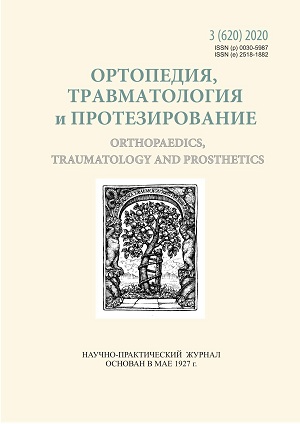Long standing forearm dislocations
DOI:
https://doi.org/10.15674/0030-59872020354-60Keywords:
elbow joint, long standing, treatmentAbstract
Dislocations that remain unreduced for 3 weeks or more, are called the chronic elbow dislocation. Today they are found quite rarely. Objective: to study the probable causes of long standing forearm dislocations, to analyze medical tactics and results of treatment. Methods: we used the data of clinical observations of 5 patients (2 men, 3 women), mean age (38 ± 8) years with long standing forearm dislocations. All patients had surgical treatment. Results: the cause of the long standing dislocations occurrence, in 2 cases there was a violation of medical recommendations by patients, in 3 — insufficient medical control, absence of control radiography after immobilization, lack of timely correction of the patient's management, erroneous the choice of conservative treatment tactics in the presence of indications for surgery. Features of treatment tactics depending on the characteristics of dislocations were analyzed. Comparative data of the joints function are given: the amplitude of flexion/extension movements before the surgery was 25° ± 6°, after — 108° ± 5°; assessment of the limb function according to Mayo Elbow Performance Index before the surgery was equal to (23 ± 5) points, in the follow-up period (17 ± 2) months) — (81 ± 7) points (p < 0.001). Conclusions: in the case of long standing posterior dislocations, open reduction of the forearm can be performed from the lateral approach with restoration of injuried ligaments, in the case of posterior-lateral — it is advisable to use posterior approach, which allows for more complete arthrolysis, tissue mobilization, restoration of ligaments, as well as perform neurolysis, transposition of the ulnar nerve. In case of short terms of long standing forearm dislocation it is possible to manage a temporary fixation of the joint with one or two wires, passed through the joint and external fixation with a plaster cast for a period of 15 up to 30 days with subsequent mobilization without the use of external fixation devices.References
- Korzh, A. A. (1957). Old dislocations of the forearm bones (causes, pathomorphological changes and treatment). Orthopedics, Traumatology and Prosthetics, 4, 21–26. [in Russian]
- Chen, N. C., Jupiter, J. B., Steinmann, S. P., & Ring, D. (2014). Nonacute treatment of elbow fracture with persistent Ulnohumeral dislocation or subluxation. The Journal of Bone and Joint Surgery, 96(15), 1308-1316. doi:10.2106/jbjs.m.00817
- Coulibaly, N., Tiemdjo, H., Sane, A., Sarr, Y., Ndiaye, A., & Seye, S. (2012). Posterior approach for surgical treatment of neglected elbow dislocation. Orthopaedics & Traumatology: Surgery & Research, 98(5), 552-558. doi:10.1016/j.otsr.2012.03.006
- Lo, C., & Chang, Y. (2004). Neglected elbow dislocation in a young man: Treatment by open reduction and elbow fixator. Journal of Shoulder and Elbow Surgery, 13(1), 101-104. doi:10.1016/s1058-2746(03)00089-2
- Anderson, D. R., Haller, J. M., Anderson, L. A., Hailu, S., Chala, A., & OʼDriscoll, S. W. (2018). Surgical treatment of chronic elbow dislocation allowing for early range of motion. Journal of Orthopaedic Trauma, 32(4), 196-203. doi:10.1097/bot.0000000000001097
- Dultsev, I. A., Zhabin, G. I., & Neverov, V. A. (2009). Surgical treatment of chronic dislocations and fracture dislocations in the elbow joint. Traumatology and Orthopedics of Russia, 1(51), 27–31. [in Russian]
- Kapukaya, A., Ucar, B. Y., & Gem, M. (2013). Open reduction and Kirschner wire fixation with triceps lengthening for neglected elbow dislocations. Journal of Orthopaedic Surgery, 21(2), 178-181. doi:10.1177/230949901302100212
- Morrey, B. F. (1993). Fracture of the radial head. The Elbow and Its Disorders, Philadelphia : W. B. Saunders Company
- Matelenok, E. M. (2010). Quantitative criterion of the degree of loss of stability of the elbow joint. Orthopedics, Traumatology and Prosthetics, 3, 35–39. DOI: 10.15674/0030-59872010335-39. [in Russian]
- Schreiber, J. J., Paul, S., Hotchkiss, R. N., & Daluiski, A. (2015). Conservative management of elbow dislocations with an overhead motion protocol. The Journal of Hand Surgery, 40(3), 515-519. doi:10.1016/j.jhsa.2014.11.016
- Jupiter, J. B., & Ring, D. (2002). Treatment of unreduced elbow dislocations with hinged external fixation. The Journal of Bone and Joint Surgery-American Volume, 84(9), 1630-1635. doi:10.2106/00004623-200209000-00017
- Morrey, B. F. (2009). Chronic unreduced elbow dislocations. The Elbow and Its Disorders, Philadelphia: Elsevier
- Ohno, Y., Shimizu, K., & Ohnishi, K. (2005). Surgically treated chronic unreduced medial dislocation of the elbow in a 70-year-old man: A case report. Journal of Shoulder and Elbow Surgery, 14(5), 549-553. doi:10.1016/j.jse.2004.08.006
- Mehta, S., Sud, A., Tiwari, A., & Kapoor, S. (2007). Open reduction for late-presenting posterior dislocation of the elbow. Journal of Orthopaedic Surgery, 15(1), 15-21. doi:10.1177/230949900701500105
Downloads
How to Cite
Issue
Section
License
Copyright (c) 2020 Ievgen Matelenok

This work is licensed under a Creative Commons Attribution 4.0 International License.
The authors retain the right of authorship of their manuscript and pass the journal the right of the first publication of this article, which automatically become available from the date of publication under the terms of Creative Commons Attribution License, which allows others to freely distribute the published manuscript with mandatory linking to authors of the original research and the first publication of this one in this journal.
Authors have the right to enter into a separate supplemental agreement on the additional non-exclusive distribution of manuscript in the form in which it was published by the journal (i.e. to put work in electronic storage of an institution or publish as a part of the book) while maintaining the reference to the first publication of the manuscript in this journal.
The editorial policy of the journal allows authors and encourages manuscript accommodation online (i.e. in storage of an institution or on the personal websites) as before submission of the manuscript to the editorial office, and during its editorial processing because it contributes to productive scientific discussion and positively affects the efficiency and dynamics of the published manuscript citation (see The Effect of Open Access).














